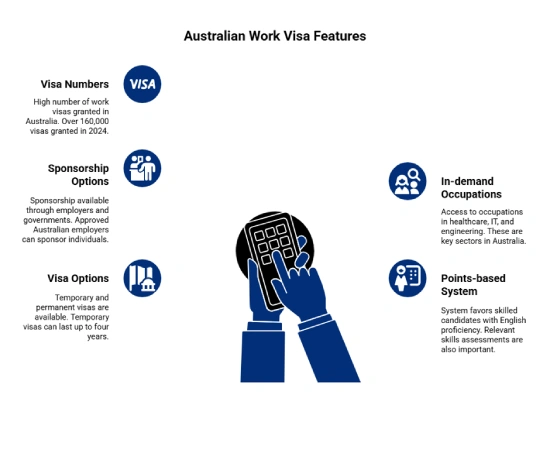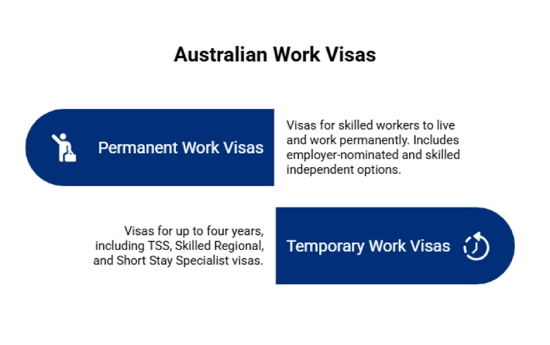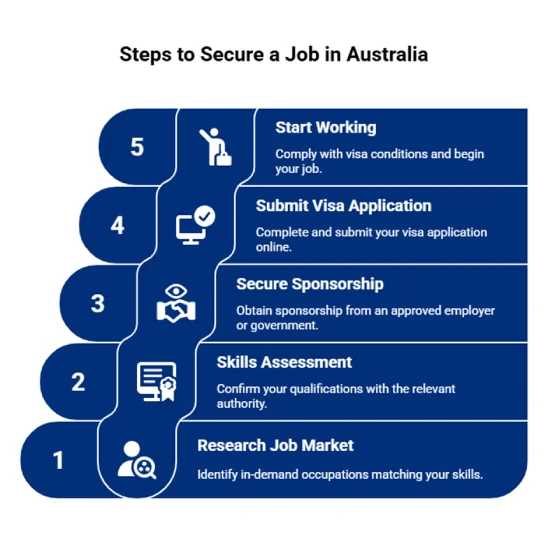If you’re based in the UAE and looking to grow your career abroad, Australia continues to be one of the top destinations for skilled professionals in 2025. With thousands of job openings and a strong economy, Australia offers real opportunities for qualified workers looking to build a better future.
Whether you’re an IT specialist, healthcare worker, engineer, or tradesperson, the demand for international talent remains high. And with supportive visa policies and employer sponsorship programs, working in Australia is more accessible than ever.

*Want guidance to apply for Australia work visa? Let Y-Axis guide you with the process.
An Australia work permit is an essential document that allows foreign nationals to legally work in Australia. It serves as official authorization from the Australian government, enabling skilled professionals to contribute to the country's dynamic workforce. Work permits can be issued on a temporary basis, typically valid for up to four years, or on a permanent basis, depending on the visa subclass and eligibility criteria.
In 2024, Australia granted over 160,000 work visas, reflecting strong demand for skilled workers across various sectors. Many work permits also provide pathways to permanent residency, allowing individuals and their eligible family members to settle in Australia long-term. Obtaining a work permit typically requires sponsorship from an approved Australian employer or state government, along with meeting specific skill and health requirements.
Highlights:
Australia offers various work visa options for immigrants aiming to live and work in the country. These visas cover temporary assignments and permanent residency pathways.The system targets skilled workers to address labor shortages in sectors like healthcare, IT, engineering, and trades. Applicants must secure sponsorship from an approved Australian employer or state/territory government, proving their skills are in demand and they have a job offer.
There are several categories of work visas available to immigrants:

Applicants must meet eligibility criteria such as suitable qualifications, a positive skills assessment, and English proficiency. Age, health, and character requirements also apply. The visa application is submitted online with a fee payment.
Visa holders can bring eligible family members and may access pathways to permanent residency, allowing them to settle permanently after meeting conditions.
Australia is known for its high standard of living, attracting skilled professionals with its strong economy, quality healthcare, education, and safe environment. The country offers competitive salaries, social benefits, and a balanced work-life culture.
Australia’s diverse job market spans healthcare, IT, engineering, construction, and trades, providing ample opportunities for skilled workers. The visa system supports professional development and allows visa holders to bring eligible family members, including de facto partners.
Applicants must secure sponsorship from an approved Australian employer or state/territory government, nominating skilled workers for in-demand roles. Working in Australia offers employment and a pathway to permanent residency and citizenship, enabling immigrants to settle permanently and enjoy full benefits.
*Looking for assistance with Australia immigration? Y-Axis is here to assist you with the process.
| Visa Subclass | Description |
|---|---|
| Employer Nomination Scheme (ENS) Visa (Subclass 186) | Allows skilled workers who are nominated by an approved Australian employer to live and work in Australia permanently. This visa is ideal for professionals who have a job offer from a sponsoring employer and wish to settle in Australia on a permanent basis. It requires meeting eligibility criteria including skills assessment, English proficiency, and health checks. |
| Regional Sponsored Migration Scheme (RSMS) Visa (Subclass 187) | Designed for skilled workers nominated by employers located in regional Australia, this visa enables applicants to live and work permanently in less populated areas. It aims to address skill shortages in regional Australia by encouraging skilled migration to these locations. Applicants must secure sponsorship from an approved regional employer and meet all visa requirements. |
| Skilled Independent Visa (Subclass 189) | This points-based visa allows invited skilled workers to live and work permanently in Australia without the need for employer sponsorship. It is suitable for highly skilled individuals whose occupations are listed on the skilled occupation list and who meet the points threshold based on factors such as age, education, work experience, and English language proficiency. |
| Skilled Nominated Visa (Subclass 190) | For skilled workers who receive nomination from a state or territory government, this visa grants permanent residency allowing applicants to live and work anywhere in Australia. Nomination is typically granted based on the applicant’s occupation being in demand in the nominating region, and applicants must meet eligibility requirements including skills assessment and English proficiency. |
| Distinguished Talent Visa | This visa is for individuals with an internationally recognized record of exceptional achievement in their profession, sport, arts, or research. It allows recipients to live and work permanently in Australia and is intended to attract highly talented people who can contribute significantly to the country’s cultural or economic development. Applicants must provide evidence of their outstanding achievements and meet health and character requirements. |
| Visa Subclass | Description |
|---|---|
| Temporary Skill Shortage (TSS) Visa (Subclass 482) | The Temporary Skill Shortage (TSS) Visa, subclass 482, allows skilled workers to live and work in Australia temporarily for up to four years. This visa requires sponsorship by an approved Australian employer who demonstrates a genuine need to fill a position that cannot be filled by local talent. It helps Australian businesses address skill shortages efficiently while ensuring compliance with labor market testing and visa conditions. |
| Skilled Regional (Provisional) Visa (Subclass 491) | This provisional visa is designed for skilled workers who wish to live and work in designated regional areas of Australia. It requires nomination by a state or territory government or sponsorship by an eligible family member residing in a regional area. The visa is valid for up to five years and provides a pathway to permanent residency for those who meet specific residency and work requirements in regional Australia. |
| Temporary Work (Short Stay Specialist) Visa (Subclass 400) | The Temporary Work (Short Stay Specialist) Visa allows individuals to undertake highly specialized, short-term work assignments in Australia, typically lasting up to three months. This visa is suitable for experts or specialists coming to Australia for specific projects or events and does not require employer sponsorship but must meet strict eligibility criteria to ensure the work is genuinely short-term and specialized. |
| Working Holiday Visa (Subclass 417) | The Working Holiday Visa offers young travelers aged 18 to 30 the opportunity to experience Australia by working and traveling for up to 12 months. This visa promotes cultural exchange and allows holders to take up short-term employment to support their travel. It is ideal for individuals seeking a flexible work and holiday experience without requiring employer sponsorship. |
The Core Skills Occupation List (CSOL) is vital to Australia's work visa system, listing in-demand occupations to address skill shortages. Regularly updated, it guides eligibility for visas like the Employer Nomination Scheme (ENS) and Skilled Independent visa.
Applicants must have their skills assessed by a relevant authority to ensure qualifications meet Australian standards. Employers and workers use the CSOL to align job offers and sponsorships with market needs, covering fields such as healthcare, engineering, IT, and trades. Understanding the CSOL improves chances of securing an Australian work permit.
If you’re planning to work abroad from the UAE, Australia offers one of the best career pathways for skilled professionals. With a valid work visa, you get the opportunity to build a stable future, enjoy a high standard of living, and take advantage of long-term PR options.
Why Choose an Australia Work Visa?
Whether you’re in IT, healthcare, construction, engineering, sales, or finance, Australia offers a future-ready platform to grow both personally and professionally.
Australia continues to face labor shortages in over 800,000 job roles. Skilled migrants with experience in high-demand sectors have better chances of getting a work visa and PR invite.
Here are some top-paying roles in 2025:
| Occupation | Annual Salary (in AUD) |
|---|---|
| IT | $110,826 |
| Marketing & Sales | $102,151 |
| Engineering | $114,198 |
| Hospitality | $80,918 |
| Healthcare | $106,963 |
| Accounting & Finance | $89,901 |
| Human Resources | $80,993 |
| STEM | $106,869 |
| Nursing | $87,750 |
| Teaching | $88,944 |
Getting a job in Australia involves a clear application process that includes meeting eligibility criteria, securing sponsorship, and submitting a visa application.
Step 1: Research the Australian job market for in-demand occupations matching your skills.
Step 2: Get a skills assessment from the relevant authority to confirm your qualifications.
Step 3: Secure sponsorship from an approved Australian employer or government.
Step 4: Submit your visa application online with required documents and fees.
Step 5: Wait for approval, then comply with visa conditions and start working.

To work legally in Australia, applicants must meet specific eligibility criteria designed to ensure they possess the necessary skills and qualifications for the job market. These requirements help maintain Australia's high standards and address current labor shortages effectively.
*Want to check your eligibility for Australia immigration? Avail Y-Axis Australia Immigration Points Calculator for FREE and instant results.
To apply for an Australia work visa, applicants must fulfill specific requirements and provide a set of essential documents to demonstrate their eligibility. These documents ensure that candidates meet the standards set by the Australian government for skilled migration.
*Want coaching for Australia immigration tests? Avail Y-Axis Coaching Services to ace the tests.
The Australia skills assessment is a key step in the visa application process for skilled workers seeking an Australia work permit. Conducted by relevant authorities like the Australian Computer Society (ACS) or Trades Recognition Australia (TRA), it verifies that qualifications and work experience meet Australian standards.
A suitable skills assessment is mandatory for most skilled visa subclasses, including the Employer Nomination Scheme (ENS) and Skilled Independent visa. Applicants must submit educational certificates, employment references, and proof of training. The assessment must be current, usually within three years.
A positive skills assessment improves visa approval chances and is essential for sponsorship by approved Australian employers or government agencies. Some visa streams require more rigorous direct entry assessments. This process ensures applicants can effectively contribute to Australia’s workforce.
Highlights:
Applying for an Australia work visa from Dubai can be complex and that’ where Y-Axis can help. With over 20 years of immigration expertise and millions of successful cases, we guide you at every stage.
With Y-Axis, you get:
Book your FREE consultation today and take the first step towards building your career in Australia!
Explore what Global Citizens have to say about Y-Axis in shaping their future
Australia Skill Stream Visa
Divya Vaidyanathan gave a feedback after
Read More...
Australia Skill Stream Visa
Aman Maan, Australia Skill Stream Visa.
Read More...
Australia Skill Stream Visa
Faisal Shah gave a feedback after receiv
Read More...
An Australia work visa allows foreign nationals to live and work legally in Australia. It can be temporary (up to four years) or permanent, often requiring skills assessment, English proficiency, health checks, and sponsorship by an approved employer or government agency.
Benefits of an Australia work visa include:
Yes, if you meet key eligibility requirements including a skilled occupation, positive skills assessment, relevant qualifications, English proficiency, sponsorship (if needed), and health and character standards.
Eligibility criteria:
Obtaining an Australia work visa involves a structured application process designed to ensure that applicants meet the country’s skilled migration requirements. Following these steps can help streamline your application and improve your chances of success.
Step 1: Identify the visa subclass that fits your skills and goals.
Step 2: Get a positive skills assessment from the relevant authority.
Step 3: Secure sponsorship or nomination from an approved employer or government, if needed.
Step 4: Collect required documents like qualifications, work experience, and health checks.
Step 5: Apply online via the Home Affairs website and pay the visa fee.
The general cost of an Australia work visa typically ranges from approximately AUD 1,290 for temporary visas like the Temporary Skill Shortage (TSS) visa to around AUD 4,240 for permanent visas such as the Employer Nomination Scheme (ENS) visa. Additional fees for health checks, police clearances, or biometrics may also apply depending on the visa type and individual circumstances.
| Visa Subclass | Approximate Application Fee (AUD) |
| Temporary Skill Shortage (TSS) Visa (Subclass 482) | 1,290 |
| Employer Nomination Scheme (ENS) Visa (Subclass 186) | 4,240 |
| Regional Sponsored Migration Scheme (RSMS) Visa (Subclass 187) | 4,240 |
| Skilled Independent Visa (Subclass 189) | 4,240 |
| Skilled Nominated Visa (Subclass 190) | 4,240 |
| Temporary Work (Short Stay Specialist) Visa (Subclass 400) | 310 |
| Working Holiday Visa (Subclass 417) | 485 |
Understanding the validity period of an Australia work visa is crucial for planning your stay and employment in the country. Different visa subclasses have varying durations based on the type of work and whether the visa is temporary or permanent. Knowing the length of your visa helps ensure compliance with visa conditions and aids in making decisions about extensions or applying for permanent residency. Below is a summary table outlining the validity periods for common Australia work visa subclasses.
| Visa Subclass | Validity Period |
| Temporary Skill Shortage (TSS) Visa (Subclass 482) | Up to 4 years |
| Temporary Work (Short Stay Specialist) Visa (Subclass 400) | Up to 3 months |
| Employer Nomination Scheme (ENS) Visa (Subclass 186) | Permanent (indefinite) |
| Regional Sponsored Migration Scheme (RSMS) Visa (Subclass 187) | Permanent (indefinite) |
You can include eligible family members like your spouse and children in your Australia work visa application. They can live, work, and study in Australia. Proof of relationship and health checks are required, with extra fees for dependents.
Benefits:
Steps to apply with family:
Step 1: Confirm your visa allows dependents.
Step 2: Gather proof of relationship and health clearances.
Step 3: Include family members in your application.
Step 4: Pay additional fees for dependents.
Step 5: Submit application online and wait for approval.
Sponsorship is essential for most Australia work permits. The popular sponsored Australia work visas are:
Here’s how the sponsorship process works:
Yes, some Australia work visas can be obtained without a job offer. These include skilled independent or nominated visas that allow individuals to live and work based on their skills rather than employer sponsorship. Key visa subclasses without job offer requirements are:
These visas target skilled professionals to fill labor shortages and offer pathways to permanent residency without employer sponsorship. Applicants must still meet eligibility criteria like skills assessment and English proficiency set by the Australian government.
Yes, it is possible to obtain an Australia work visa without IELTS in some cases, but English proficiency remains compulsory for most skilled visas. Alternatives like PTE, TOEFL, or Cambridge English are accepted depending on the visa subclass. Some streams may accept evidence of English-based education or work experience.
For visas like the Employer Nomination Scheme (ENS) and Temporary Skill Shortage (TSS), meeting English requirements is mandatory to avoid delays or refusals. Check the specific visa subclass requirements on the Australian Government Department of Home Affairs website or consult an expert to confirm if IELTS is compulsory for your application.
Transitioning from an Australia work visa to permanent residency (PR) is common for skilled workers. It involves applying for a permanent visa after gaining relevant Australian work experience and meeting key requirements like skills assessment, English proficiency, and the likes.
Eligibility criteria for transitioning from an Australia work visa to Australia PR include:
By meeting these criteria, skilled workers on temporary visas can apply for permanent residency, allowing them to live and work in Australia permanently with full benefits as permanent residents.